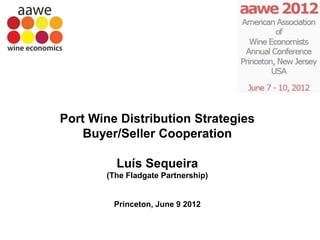PRINCETON 9 Junho
- 1. Port Wine Distribution Strategies Buyer/Seller Cooperation Luís Sequeira (The Fladgate Partnership) Princeton, June 9 2012
- 4. Research Model Mixed methods (qualitative and quantitative) were used based on the pragmatistic paradigm Generalization Hypotesis Inductive Deductive Model Model Case Studies Inquiry Qualitative Methodology Quantitative Methodology 4
- 5. Research Model Qualitative Methodology – Case Studies Generalization -Exploratory case structured interview; Inductive - convenience sampling; Model -Unit of analysis: Evolution of Port wine distribution of a specific Case Studies company in key markets: (UK, France and Netherlands). Qualitative Methodology 5
- 6. Research Model Qualitative Methodology – Case Studies
- 7. Research Model Quantitative Methodology – Questionnaire Hypothesis Convenience Sample. Port Wine Producers and Inductive distribution companies. Model Sample: 101 companies Inquiry Returned questionnaires: 61 (61,4%) Quantitative Methodology 7
- 8. Hypothesis testing - The dependent variable was categorised as either cooperation or non-cooperation. - The existence of a strong correlation between the dependent variable and the independent variables may invalidate the use of a linear regression model. To check for multicollinearity between independent variables, the correlation matrix of independent variables in Table 1 was constructed. The highest value being 0.249, between the independent variables ‘adaptation’ and ‘trust’, it is clear that correlations are in general low and multicollinearity is not a problem.
- 9. Hypothesis testing -After five interactions, the model correctly predicted 83.6% of the observations, demonstrating that the results were very satisfactory. -Good results were also achieved for sensitivity (dependent variable = 1 = cooperation) and specificity (dependent variable = 0 = non-cooperation). - Overall, the estimated equation is 18% better at predicting responses than the constant probability model.
- 10. Hypothesis testing -Results of Probit analysis, based on the z statistic. - The values of between 0.2 and 0.4 can be considered very good, according to McFaden (1976), our model yielding a result of 0.367.
- 11. Hypothesis testing Hyp. Description Result. H1 Supply chain management capabilities promote cooperation between channel members. not conf. H2 The exercise of coercive power exerts a negative impact on cooperation amongst channel members not conf. H3 Persistent and intense conflict constitutes an obstacle to cooperation in marketing channels confirmed H4 The greater the level of trust, the greater the propensity to cooperate amongst channel members confirmed H5 Increased interdependence enhances cooperation between channel members. not conf. H6 The greater the capacity to adapt, the greater the willingness to cooperate amongst channel members confirmed H7 The presence of a foreign sales representative does not constrain cooperation in the marketing channel confirmed H8 Opportunistic behaviour has a negative impact on the development of cooperative relationships not conf.
- 13. Conclusions -Taking into account the strategic alternatives available for the distribution of Port, it seems important that the industry diversifies its options by embracing multiple channels; - Conflict, when permanent and intense, inhibits the development of cooperative relationships; - Trust is likely to solve conflicts; - A combination of trust and adaptation increases the potential for cooperation; - Cooperation can be considered as an important means of developing skills and resources, which can then be applied to existing transactional relationships.













